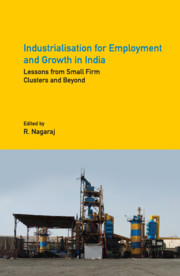Book contents
- Frontmatter
- Contents
- List of Tables
- List of Figures and Maps
- Preface and Acknowledgements
- 1 Introduction
- 2 Garment Cluster in Kolkata: The Untold Story of Expansion Relying on Low-end Domestic Demand
- 3 Constraints to Upgrading and Employment Expansion in the Tiruppur Knitwear Cluster
- 4 Determinants of Employment in the Indian Automobile Industry
- 5 Upgrading Technology and Space as Collective Strategy: Creation of Jobs and Market Potential in Gujarat’s Ceramic Clusters
- 6 Sports Equipment Manufacturing in India: A Firm-level Inquiry into Growth and Employment Dynamism
- 7 Aligarh Lock Cluster: Unravelling the Major Impediments
- 8 Continued Misery or a Change in Fortune? The Case of the Howrah Foundry Industry
- 9 Redevelop and Perish, or Survive and Grow? The Case for Supporting Informal Leather Enterprises in Dharavi, Mumbai
- 10 Growth Performance, Competitiveness and Employment in MSMEs: A Case Study of the Rajkot Engineering Cluster
- 11 Manufacturing and Automation
- About the Contributors
- Index
10 - Growth Performance, Competitiveness and Employment in MSMEs: A Case Study of the Rajkot Engineering Cluster
Published online by Cambridge University Press: 31 July 2021
- Frontmatter
- Contents
- List of Tables
- List of Figures and Maps
- Preface and Acknowledgements
- 1 Introduction
- 2 Garment Cluster in Kolkata: The Untold Story of Expansion Relying on Low-end Domestic Demand
- 3 Constraints to Upgrading and Employment Expansion in the Tiruppur Knitwear Cluster
- 4 Determinants of Employment in the Indian Automobile Industry
- 5 Upgrading Technology and Space as Collective Strategy: Creation of Jobs and Market Potential in Gujarat’s Ceramic Clusters
- 6 Sports Equipment Manufacturing in India: A Firm-level Inquiry into Growth and Employment Dynamism
- 7 Aligarh Lock Cluster: Unravelling the Major Impediments
- 8 Continued Misery or a Change in Fortune? The Case of the Howrah Foundry Industry
- 9 Redevelop and Perish, or Survive and Grow? The Case for Supporting Informal Leather Enterprises in Dharavi, Mumbai
- 10 Growth Performance, Competitiveness and Employment in MSMEs: A Case Study of the Rajkot Engineering Cluster
- 11 Manufacturing and Automation
- About the Contributors
- Index
Summary
Introduction
The last three decades or so have often been labelled as the decades of ‘jobless growth’ in India. The employment content of growth has decelerated over the years. It has been stark in the organised manufacturing sector (Papola 2014). The share of the manufacturing sector in gross domestic product (GDP) still hovers around 16 per cent, up merely by 0.57 per cent during the last 10 years. The slow growth was ascribed to the stifling and over-regulated policy framework. The political dispensation in the 1990s realised these constraints and started dismantling some of the archaic rules and regulations, though at a snail's pace.
Realising that the growth of the manufacturing sector is vital to generate sustainable and decent employment, the Government of India envisaged the manufacturing sector to contribute 25 per cent, up from the current 16.57 per cent, to the GDP and create 100 million jobs by 2022, under its ‘Make in India’ campaign, announced on 25 September 2014. As per the campaign, both domestic and foreign entrepreneurs are encouraged to set up their manufacturing facilities in India, produce and trade globally, besides catering to the vast Indian market. Such investments, it is envisioned, will create incomes and jobs for millions of youth, besides augmenting exports and foreign exchange earnings.
Within the manufacturing sector, the track record of organised large-scale industries in creating employment, as stated earlier, has been somewhat disappointing. The performance of the micro, small and medium enterprises (MSME) sector in this regard has been noteworthy (Gade 2018). MSMEs have continued to employ a larger number of semi-skilled and un-skilled workers, over the years, compared to the large-scale enterprises. Not only in India but elsewhere too, such as in the USA, small and medium enterprises (SMEs) have been generating more jobs than the large ones (Katua 2014; United Capital 2019). In India, a characteristic feature of the development of SMEs has been their emergence and growth in a clustered form (Awasthi 2004).
Industrial Clusters: A Road to Competitiveness
Both developed and developing countries have witnessed the congregated emergence of SMEs, widely known as ‘industrial clusters’. From Marshal (1974 [1890]) to Porter (1990), industrial clusters have travelled a long way.
- Type
- Chapter
- Information
- Industrialisation for Employment and Growth in IndiaLessons from Small Firm Clusters and Beyond, pp. 223 - 249Publisher: Cambridge University PressPrint publication year: 2021



